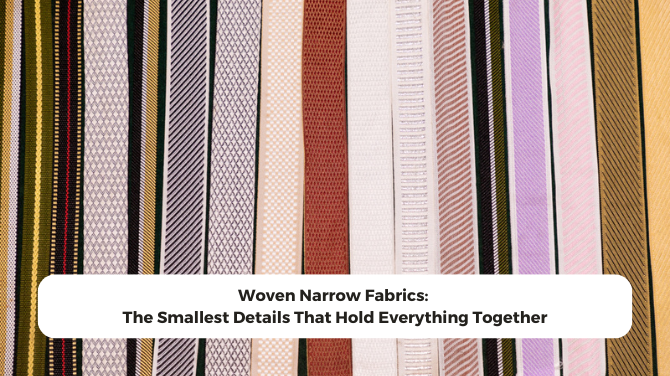It’s funny how we often overlook the smallest parts of a garment. We obsess over fabric swatches and silhouettes, but forget to talk about the trims that do the heavy lifting—literally. From the elastic in waistbands to the straps on bags, woven narrow fabrics are everywhere, just doing their job quietly.
A few seasons ago, we had a buyer visit our mill. She picked up a woven tape roll from our samples table, turned it over in her hands, and said, “This? This tiny thing holds the entire backpack together.” She wasn’t wrong. Narrow fabrics may look simple, but they carry a lot of weight, both literally and in terms of performance.
What Exactly Are Woven Narrow Fabrics?
Let’s break it down.
Woven narrow fabrics are strips of fabric that are typically under 30 cm wide. They’re made using a shuttle loom or needle loom and are constructed with tightly woven yarns, just like wider woven fabrics—but on a smaller scale.
They come in various forms: twill tapes, webbings, grosgrain, jacquard trims, elastic tapes, and more. And they’re used across industries, not just in fashion.
So even if you haven’t paid attention to them yet, they’ve definitely been a part of something you wore or carried this week.
Where Do You See Woven Narrow Fabrics in Use?
Pretty much everywhere. Here are a few common uses:
- Garments: Waistbands, drawstrings, shoulder straps, labels, bra straps, hook-and-loop tape, and uniform trims
- Footwear: Binding tapes, reinforcement straps, and lace loops
- Accessories: Bags, belts, handles, sling straps, and trims
- Home textiles: Curtain tapes, edging for mats or quilts
- Industrial & safety wear: Reflective tapes, harnesses, and reinforced webbings
- Medical use: Bandages, surgical tapes, and support straps
In short, woven narrow fabrics are used wherever strength, structure, or a neat finish is needed in a small space.
What Makes These Fabrics So Functional?
Woven narrow fabrics are strong, durable, and often built to resist wear and tear. Their tight weave makes them:
- Resistant to fraying or stretching (especially important for weight-bearing straps)
- Highly customizable in terms of width, pattern, and color
- Versatile across product categories
- Ideal for branding, as logos or jacquard weaves can be embedded directly
If you’re designing a product that needs strength in the details, this is where narrow fabrics shine.
Materials Commonly Used
The material choice depends on the end use. Some of the most common yarns and blends include:
- Cotton: Soft, breathable, and ideal for garments or baby products
- Polyester: Strong, water-resistant, and great for bags, uniforms, or outdoor use
- Nylon: High-tensile strength, used in straps and industrial applications
- Lycra blends: Used for stretch trims or waistband tapes
- Recycled fibers: More brands are opting for GRS-certified narrow fabrics to meet sustainability goals
What to Keep in Mind When Sourcing Woven Narrow Fabrics
If you’re placing an order or developing a new style, here are a few sourcing tips:
- Specify the width clearly. A few millimeters make a big difference in how the final product looks.
- Decide the function first. Will it stretch? Carry weight? Be visible branding? Each use case needs a different weave.
- Ask for samples. Don’t go off visuals alone. Narrow fabrics often feel very different from what you expect.
- Check certifications if your product line is sustainable. You can now get GOTS or GRS-certified narrow fabrics too.
- Match colors to bulk fabric if needed. Especially for visible trims like bag handles or drawstrings.
Final Thoughts
Woven narrow fabrics might not be the star of the show, but they’re the backbone. They support, reinforce, hold, and finish everything from high-fashion garments to hiking gear. Without them, your product would literally fall apart.
So next time you plan your sourcing list, give narrow fabrics the attention they deserve. They’re small, yes—but mighty.
Want to explore our latest trims, tapes, and webbing options? We’ve got digital swatches ready to go. If you are looking for a reliable woven fabric manufacturer, please contact us.

